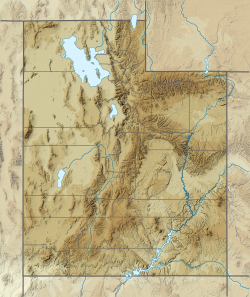Top Qs
Timeline
Chat
Perspective
The West Temple
Mountain in the state of Utah From Wikipedia, the free encyclopedia
Remove ads
The West Temple is a prominent 7,810-foot (2,380 m) mountain summit composed of Navajo Sandstone in Zion National Park in Washington County of Utah, United States. The West Temple, the highest feature in Zion Canyon, was originally called "Temp-o-i-tin-car-ur", meaning "Mountain Without a Trail" by the Paiute people.[4] It was called "Steamboat Mountain" by local Mormon settlers before 1934, when the USGS officially changed it to its present name, which was applied by John Wesley Powell during his explorations in 1872.[5] West Temple is situated two miles northwest of Springdale, Utah, one mile northeast of Mount Kinesava, and two miles west of the park headquarters. It is one of the notable landmarks in the park. The nearest higher peak is Windy Peak, 10.46 miles (16.83 km) to the north.[1] Precipitation runoff from the mountain drains into tributaries of the Virgin River.
Remove ads
Remove ads
Climbing Routes

Climbing Routes on The West Temple[6]
- Southwest Ridge: class 5.6, 10 pitches
- Back Where It All Begins: class 5.11a, 16 pitches
- Big Lebowski: class 5.11a/b, 21 pitches
- Lovelace: class 5.10, 9 pitches
- Big Lie: class 5.10+, 2 pitches
Geology
The upper white cliffs are composed of Navajo Sandstone, which in some places exhibit reddish staining caused by hematite (iron oxide), the source of which is the Temple Cap Formation caprock at the summit.[7] Lower slopes and ledges are composed of Kayenta Formation, Moenave Formation, Chinle Formation, and Moenkopi Formation.
Climate
Spring and fall are the most favorable seasons to visit this feature. According to the Köppen climate classification system, it is located in a Cold semi-arid climate zone, which is defined by the coldest month having an average mean temperature below 32 °F (0 °C), and at least 50% of the total annual precipitation being received during the spring and summer. This desert climate receives less than 10 inches (250 millimeters) of annual rainfall, and snowfall is generally light during the winter.[8]
See also
References
External links
Wikiwand - on
Seamless Wikipedia browsing. On steroids.
Remove ads




